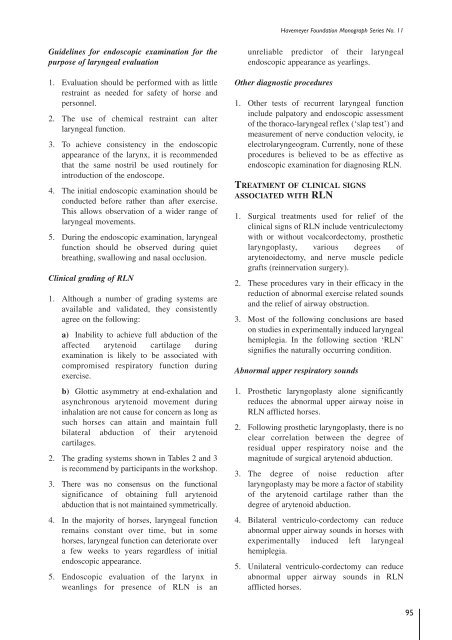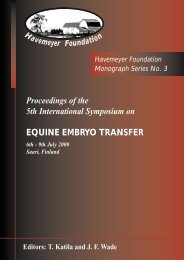Proceedings of a Workshop on - The Havemeyer Foundation
Proceedings of a Workshop on - The Havemeyer Foundation
Proceedings of a Workshop on - The Havemeyer Foundation
Create successful ePaper yourself
Turn your PDF publications into a flip-book with our unique Google optimized e-Paper software.
<strong>Havemeyer</strong> Foundati<strong>on</strong> M<strong>on</strong>ograph Series No. 11<br />
Guidelines for endoscopic examinati<strong>on</strong> for the<br />
purpose <str<strong>on</strong>g>of</str<strong>on</strong>g> laryngeal evaluati<strong>on</strong><br />
1. Evaluati<strong>on</strong> should be performed with as little<br />
restraint as needed for safety <str<strong>on</strong>g>of</str<strong>on</strong>g> horse and<br />
pers<strong>on</strong>nel.<br />
2. <strong>The</strong> use <str<strong>on</strong>g>of</str<strong>on</strong>g> chemical restraint can alter<br />
laryngeal functi<strong>on</strong>.<br />
3. To achieve c<strong>on</strong>sistency in the endoscopic<br />
appearance <str<strong>on</strong>g>of</str<strong>on</strong>g> the larynx, it is recommended<br />
that the same nostril be used routinely for<br />
introducti<strong>on</strong> <str<strong>on</strong>g>of</str<strong>on</strong>g> the endoscope.<br />
4. <strong>The</strong> initial endoscopic examinati<strong>on</strong> should be<br />
c<strong>on</strong>ducted before rather than after exercise.<br />
This allows observati<strong>on</strong> <str<strong>on</strong>g>of</str<strong>on</strong>g> a wider range <str<strong>on</strong>g>of</str<strong>on</strong>g><br />
laryngeal movements.<br />
5. During the endoscopic examinati<strong>on</strong>, laryngeal<br />
functi<strong>on</strong> should be observed during quiet<br />
breathing, swallowing and nasal occlusi<strong>on</strong>.<br />
Clinical grading <str<strong>on</strong>g>of</str<strong>on</strong>g> RLN<br />
1. Although a number <str<strong>on</strong>g>of</str<strong>on</strong>g> grading systems are<br />
available and validated, they c<strong>on</strong>sistently<br />
agree <strong>on</strong> the following:<br />
a) Inability to achieve full abducti<strong>on</strong> <str<strong>on</strong>g>of</str<strong>on</strong>g> the<br />
affected arytenoid cartilage during<br />
examinati<strong>on</strong> is likely to be associated with<br />
compromised respiratory functi<strong>on</strong> during<br />
exercise.<br />
b) Glottic asymmetry at end-exhalati<strong>on</strong> and<br />
asynchr<strong>on</strong>ous arytenoid movement during<br />
inhalati<strong>on</strong> are not cause for c<strong>on</strong>cern as l<strong>on</strong>g as<br />
such horses can attain and maintain full<br />
bilateral abducti<strong>on</strong> <str<strong>on</strong>g>of</str<strong>on</strong>g> their arytenoid<br />
cartilages.<br />
2. <strong>The</strong> grading systems shown in Tables 2 and 3<br />
is recommend by participants in the workshop.<br />
3. <strong>The</strong>re was no c<strong>on</strong>sensus <strong>on</strong> the functi<strong>on</strong>al<br />
significance <str<strong>on</strong>g>of</str<strong>on</strong>g> obtaining full arytenoid<br />
abducti<strong>on</strong> that is not maintained symmetrically.<br />
4. In the majority <str<strong>on</strong>g>of</str<strong>on</strong>g> horses, laryngeal functi<strong>on</strong><br />
remains c<strong>on</strong>stant over time, but in some<br />
horses, laryngeal functi<strong>on</strong> can deteriorate over<br />
a few weeks to years regardless <str<strong>on</strong>g>of</str<strong>on</strong>g> initial<br />
endoscopic appearance.<br />
5. Endoscopic evaluati<strong>on</strong> <str<strong>on</strong>g>of</str<strong>on</strong>g> the larynx in<br />
weanlings for presence <str<strong>on</strong>g>of</str<strong>on</strong>g> RLN is an<br />
unreliable predictor <str<strong>on</strong>g>of</str<strong>on</strong>g> their laryngeal<br />
endoscopic appearance as yearlings.<br />
Other diagnostic procedures<br />
1. Other tests <str<strong>on</strong>g>of</str<strong>on</strong>g> recurrent laryngeal functi<strong>on</strong><br />
include palpatory and endoscopic assessment<br />
<str<strong>on</strong>g>of</str<strong>on</strong>g> the thoraco-laryngeal reflex (‘slap test’) and<br />
measurement <str<strong>on</strong>g>of</str<strong>on</strong>g> nerve c<strong>on</strong>ducti<strong>on</strong> velocity, ie<br />
electrolaryngeogram. Currently, n<strong>on</strong>e <str<strong>on</strong>g>of</str<strong>on</strong>g> these<br />
procedures is believed to be as effective as<br />
endoscopic examinati<strong>on</strong> for diagnosing RLN.<br />
TREATMENT OF CLINICAL SIGNS<br />
ASSOCIATED WITH RLN<br />
1. Surgical treatments used for relief <str<strong>on</strong>g>of</str<strong>on</strong>g> the<br />
clinical signs <str<strong>on</strong>g>of</str<strong>on</strong>g> RLN include ventriculectomy<br />
with or without vocalcordectomy, prosthetic<br />
laryngoplasty, various degrees <str<strong>on</strong>g>of</str<strong>on</strong>g><br />
arytenoidectomy, and nerve muscle pedicle<br />
grafts (reinnervati<strong>on</strong> surgery).<br />
2. <strong>The</strong>se procedures vary in their efficacy in the<br />
reducti<strong>on</strong> <str<strong>on</strong>g>of</str<strong>on</strong>g> abnormal exercise related sounds<br />
and the relief <str<strong>on</strong>g>of</str<strong>on</strong>g> airway obstructi<strong>on</strong>.<br />
3. Most <str<strong>on</strong>g>of</str<strong>on</strong>g> the following c<strong>on</strong>clusi<strong>on</strong>s are based<br />
<strong>on</strong> studies in experimentally induced laryngeal<br />
hemiplegia. In the following secti<strong>on</strong> ‘RLN’<br />
signifies the naturally occurring c<strong>on</strong>diti<strong>on</strong>.<br />
Abnormal upper respiratory sounds<br />
1. Prosthetic laryngoplasty al<strong>on</strong>e significantly<br />
reduces the abnormal upper airway noise in<br />
RLN afflicted horses.<br />
2. Following prosthetic laryngoplasty, there is no<br />
clear correlati<strong>on</strong> between the degree <str<strong>on</strong>g>of</str<strong>on</strong>g><br />
residual upper respiratory noise and the<br />
magnitude <str<strong>on</strong>g>of</str<strong>on</strong>g> surgical arytenoid abducti<strong>on</strong>.<br />
3. <strong>The</strong> degree <str<strong>on</strong>g>of</str<strong>on</strong>g> noise reducti<strong>on</strong> after<br />
laryngoplasty may be more a factor <str<strong>on</strong>g>of</str<strong>on</strong>g> stability<br />
<str<strong>on</strong>g>of</str<strong>on</strong>g> the arytenoid cartilage rather than the<br />
degree <str<strong>on</strong>g>of</str<strong>on</strong>g> arytenoid abducti<strong>on</strong>.<br />
4. Bilateral ventriculo-cordectomy can reduce<br />
abnormal upper airway sounds in horses with<br />
experimentally induced left laryngeal<br />
hemiplegia.<br />
5. Unilateral ventriculo-cordectomy can reduce<br />
abnormal upper airway sounds in RLN<br />
afflicted horses.<br />
95








